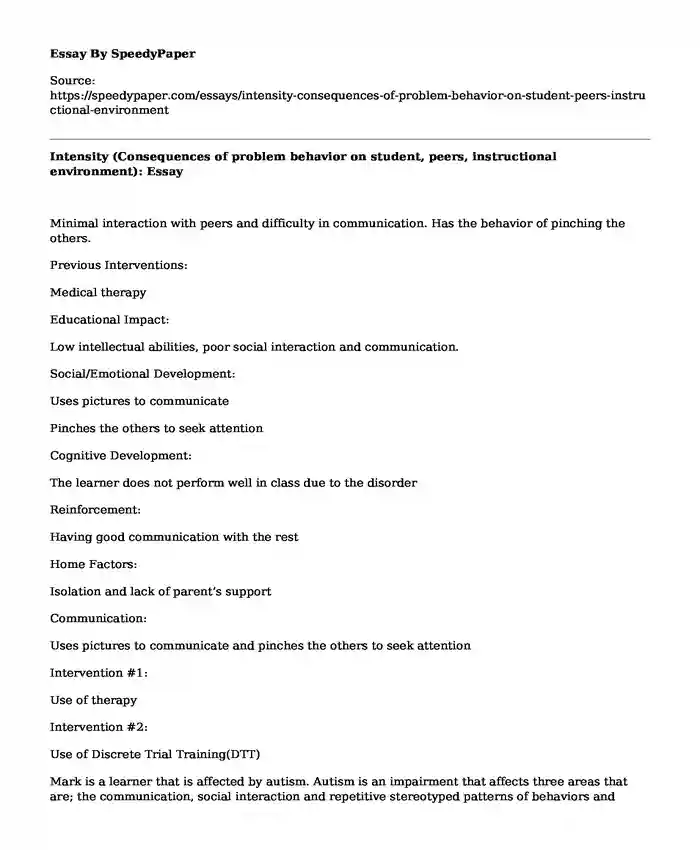Minimal interaction with peers and difficulty in communication. Has the behavior of pinching the others.
Previous Interventions:
Medical therapy
Educational Impact:
Low intellectual abilities, poor social interaction and communication.
Social/Emotional Development:
Uses pictures to communicate
Pinches the others to seek attention
Cognitive Development:
The learner does not perform well in class due to the disorder
Reinforcement:
Having good communication with the rest
Home Factors:
Isolation and lack of parent's support
Communication:
Uses pictures to communicate and pinches the others to seek attention
Intervention #1:
Use of therapy
Intervention #2:
Use of Discrete Trial Training(DTT)
Mark is a learner that is affected by autism. Autism is an impairment that affects three areas that are; the communication, social interaction and repetitive stereotyped patterns of behaviors and activities. Mark has difficulty in the articulation of words and communication; thus he uses pictures for communication. According to the case study Mark's behavior is changed and is pinching people repeatedly then laughs; he is trying to attract the people's attention. This essay seeks to discuss on the research-based interventions that can assist solve the autism problem among the children.
First, research shows that there is no cure for autism but having psychological therapy assists a great deal because people living with autism are affected intellectually. For instance, Mark is changed intellectually thus is in affirmative class. Nonetheless, he does not interact freely with the other students. Moreover, no intervention fits all the victims of autism because this disorder differs from one individual to another. Therefore, a valid response is to follow the principles of different individuals. There should be a provision of active engagement of the child in various activities so that he/she does not feel lonely. In school environs, there should be a low teacher to learner ration so that the affected child will have one on one interaction with the teacher this will aid in improving their academic performances as well as intellectual abilities.
There is also the use of Functional Communication Training (FCT) which is one of the behavioral methodologies that replace the inappropriate behaviors of an individual with excellent communication. The communicative functions and disruptions such as Mark's pinching behavior are to seek people's attention, thus with (FCT) the responses are taught, and there is the replacement of the problem behaviors, good behaviors. Furthermore, it is known that FCT is among the strong research-based interventions as it is using single-subject research designs which aid in reducing the problem of intellectual behaviors such as Mark's behavior of pinching to seek attention and replaces it with an increase in communication as well as social interaction.
Additionally, there is the use of Discrete Trial Training (DTT which is behavioral learning theory and sometimes it is referred to as Lovaas therapy. Using this intervention indicates that the child who is a victim of autism with the characteristic of discriminative stimulus receives a reward after the change of behavior basing on the response. The intervention is best suited for skills that can be taught repeatedly. Research depicts that the use of (DTT) can produce powerful behavioral outcomes especially on language areas, imitation, emotional expression and the reduction of aggressive behaviors.
In conclusion, the above interventions are vital for changing the behaviors of autism patients because in most cases autism affects children that are below three years. Besides, having adequate therapy and medical attention reduces the adverse effects of autism patients. There is good evidence that interventions of direct training on social skills can be effective thus increasing the social interaction and decreasing aggressive behaviors. Perhaps using peer-mediated interventions will assist a great deal in building social skills. Eye contact interaction helps in maintaining the concentration of the child and developing seriousness; thus the child can improve on the aspect of social interaction.
Cite this page
Intensity (Consequences of problem behavior on student, peers, instructional environment):. (2022, Dec 15). Retrieved from https://speedypaper.com/essays/intensity-consequences-of-problem-behavior-on-student-peers-instructional-environment
Request Removal
If you are the original author of this essay and no longer wish to have it published on the SpeedyPaper website, please click below to request its removal:
- Self-esteem Research Essay Example
- Essay Sample on Blue Bell Creameries
- Free Essay: EGCG Substance in Green Tea Inhibits Inflammatory Breast Cancer Cells
- Civil War Essay Example - Opening Moves
- Sources of Elementary Education Essay Example
- Essay Sample on Health Care Systems: Variations Across the Globe
- Free Paper Example on Evidence Based Practice
Popular categories





